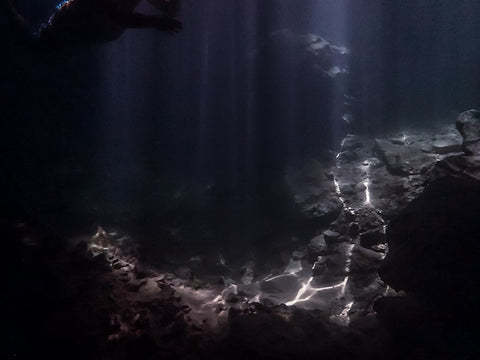What do the crystal tourmaline waters of a Mexican cenote and extinction have in common? Well, everything.
Approximately 66 million years ago, a large asteroid crashed into the Earth along the northern coastline of the Yucatán peninsula and into the Gulf of Mexico. The Chicxulub crater, named after the Yucatán town near the center of the crater, is 93 miles (150 km) in diameter reaching a depth of 12 miles (20 km) down into the continental crust. This massive impact caused earthquakes, volcanic eruptions, megatsunamis, and the sky filled with debris and dust for years. There are over 6000 cenotes in the Yucatán forming a ring around the impact zone. It is believed that water from the Gulf entered the limestone bedrock via the impact and the falling debris collapsed the land's surface into open pits or sinkholes. This cataclysmic impact is associated with the mass extinction event of the dinosaurs and seventy-five percent of life on the surface of planet Earth. And all those tourists think they are just swimming in some pretty water.
What is a cenote?
Cenote is the Yucatec Maya word, 'ts'onot,' referring to any location with accessible groundwater. A cenote in geological terms is a natural sinkhole into limestone bedrock exposing groundwater underneath. These formations happen in low-lying areas near the coast or on an island. The cenotes of the Yucatán peninsula include a complex maze of underground caves. Visitors to the region can experience the refreshing tranquil waters of a cenote with a guided swim tour of a cave system or a deep scuba dive into the Maya Underworld.


The universe for the ancient Maya is made of 3 realms, sky, earth, and the underworld. Each realm is related to particular states of being. In the sky or 'kan' resides the celestial deities. The Earth is for the living and Xibalba is the watery underworld of danger, deities, and is where life began. Caves and cenotes are the revered entrances to the underworld. Pyramid and temple complexes throughout Mesoamerica are often near these entrances. Underwater cave exploration in the Yucatán has discovered many precious Maya artifacts and human remains that are believed to have been sacrificial offerings to the gods of the underworld. The shadowy depths inside a cenote are certainly something to be revered.

Cenotes are a popular tourist attraction throughout Yucatán, Mexico. There are many guided tours of the underwater caves. Other cenotes offer grand pools inside gigantic caverns perfect for a refreshing swim on a hot day. Cody and I toured the spectacular caves and pools of
Cenotes Casa Tortuga. Swimming in the dark from an underground cave to a partially sunlit pool affirms life and living with each breath. The water is so clear, it's as if we are glimpsing the other side of a mirror or as the Maya believed the realm of the underworld.





Leave a comment
Please note, comments must be approved before they are published